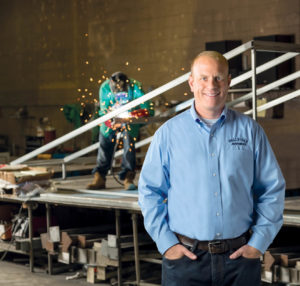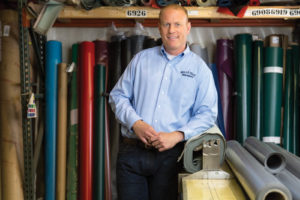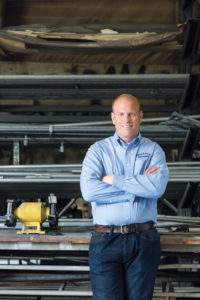
I went to school with many kids whose parents had businesses, and they thought that just because their parents ran a successful business, they could just step in and be successful as well,” says Blair Belluomo, owner and president of Belle Isle Awning in Roseville, Mich. “So many of them failed because they hadn’t had other work experiences before they took over.”
Blair’s great-grandfather William Belluomo launched Belle Isle Awning in 1931 after years of crafting high-quality sails for yachtsmen and merchant seamen on the Detroit River. The company has prospered under what is now four generations of leadership. “I’m very proud of the fact that we’re one of the few awning companies I know of that has passed down directly from father to son for four generations,” Blair says. “Now my whole objective is keep the business strong for my kids (four-year-old-twins) if this is what they eventually want to do.”
Judging by how things are going now, Blair is off to a good start. The business will have doubled its billing since he took over in 2012. “I was fortunate to have gone somewhere else to work for a while and learn a few things about business,” he says. “And my dad is a fantastic awning man. He knows the business from top to bottom. We put our skills together and the business is running very well.”
After graduating from Northwood University in Midland, Mich., Blair went to work for what he calls one of the nation’s biggest and best-run auto dealer groups. He started in lower-level management and by the time he left 10 years later, he was managing 120 people at a car dealership. “To me, that experience was invaluable. I had a very good mentor and he let me be successful, and he let me fail. That helped me incorporate my ability to teach things I know to others, to let them make mistakes and grow and learn from them.”
Each one teach one
One of the first things Blair did when he bought Belle Isle Awning was to institute an informal apprenticeship program. “I realized that our workforce was getting older, so I saw the benefit of assigning each of our senior employees an apprentice,” he says. “The foreman, the seamstress, the senior installers—they all have somebody working under them.”
That apprenticeship relationship goes for Blair as well. Although he purchased the company from his father, his father still works there as a consultant, and Blair relies on his expertise and experience to help him lead the company. “When he suggests something, I listen,” Blair says.
The two kept in mind, however, that that kind of leadership transition benefits from clear and written agreements. “We drafted a consulting contract, spelling out how many hours a week he would work, how many days and what his responsibilities are,” Blair says. “Of course, he works more than what’s in the agreement, but it’s helpful to have defined lines.”
 Virtual balance
Virtual balance
Although Blair maintains the same dedication to the quality of work and running the business that his father did, he approaches a few things in his own way. Take technology, for one. Blair embraces new technologies, both in the way he connects with clients and in design and manufacture. He’s a huge fan of using Google Earth to bid jobs. “Back when my dad was running the company he was driving 30,000 to 35,000 miles a year. I drive between 15,000 and 16,000 miles a year because I’m using Google Earth,” he says.
Not surprisingly, Blair saves time by bidding jobs that way, but he points out that the practice also enhances the quality of his connections when he does meet clients face to face. “It’s always best to meet people face to face at some point,” he says. “But if you can give them a ball park bid before you’ve even met them, your success rate is higher.”
The company also recently began using Awning Composer® software. “We’ve just signed up for their new estimating tool
and I expect that it’s going to be amazing,” Blair says. “We have all the seam sealers and welders and they’re great, but I still think the best technology you have to use is your computer.”
Getting and keeping employees
The company’s best assets, however, are its employees, Blair says. “They count on me to keep the place running properly and that they’re going to get paid every week, and I trust them to do the job the right way,” he says. “When I first took over the company I spent a lot of time on the employees, taking them out to lunch and having conversations with them about their lives. It’s important to show your appreciation.”
In addition to providing ongoing training for existing employees, Blair is constantly on the lookout for new talent—from sales to sewers. “You have to constantly be training, teaching and reviewing—and interviewing new people,” he says. “I try to interview somebody every week. I know that sounds crazy, but I’m always looking to have a bank of people. We’re fortunate that many of our employees have been with us for a long time, but there’s always turnover.”
To help him find potential new hires, Blair turns to his employees. “Your best resource for finding employees is your employees,” he says. “If you have an employee that’s a hard worker, typically the type of people he or she runs with are the same kind of people.”
Talk isn’t cheap—it’s invaluable
When it comes to getting—and keeping—clients, Blair relies on keeping the lines of communication open. Along with the many benefits of technological advances comes an expectation of instant information. “If somebody sends you an email on the weekend, you’ve got to answer it on the weekend or they’re going to contact somebody else,” he says.
With existing clients, if there’s a glitch—such as a recent project for which it took 10 months to secure permitting—Blair makes sure to keep them in the loop. “It’s important to deliver bad news in a timely fashion,” he says. “For that particular project it got tense a few times. I had to drive out there and tell the owner in person what was going on, and we ended up going to City Hall together to talk to the inspector—who was nowhere to be found. But the constant communication kept the deal together.”
Similarly, when a crew member broke a window during a residential awning installation, Blair and the crew member called the owner together to tell him what happened and that Belle Isle would take care of it right away. “The owner was out of town and couldn’t believe we called him on the same day it happened and admitted it,” Blair says. “I never get mad about it because it happens so little, and it’s important to treat people with respect.”
5 Top Tips for working with family
- Be sure you have a strong relationship with family members before deciding to work together.
- Resolve not to let the business affect your family relationships.
- Leave work at work. Don’t bring it home.
- Spell out expectations in writing.
- Be humble. Listen to suggestions.
Permits, patience—and first-class awnings
When the owners of Vince & Joe’s Gourmet Market in Shelby Township, Mich., hired Belle Isle Awning to construct a series of awnings to expand its space at the entrance, little did any of the participants know that although the installation would only take two months, the permitting process would take 10 months. Completed in June 2016, the awnings cover the store’s 125-by-14-foot outdoor market that houses the flower department and shopping carts.
“This project is gorgeous,” says Blair Belluomo, owner and president of Belle Isle Awning. “But we provided three sets of engineered drawings and it took 10 months to get the permit approved, which can kill a job.”
Blair points out that constant communication with the owners helped them all get through the drawn-out permitting process and keep the project on track. “The worst thing in the world you can do is over-promise and under-deliver,” Blair says. “I constantly let them know where the process was at.”
Even so, the process got tense at times. “There were times when I had to drive out there myself and spend time managing people’s expectations and helping them understand what we were up against,” Blair says. “Now that the project is finished, though, we’re extremely proud of how it turned out.”
What is the biggest challenge the awning industry is currently facing?
Codes and regulations are the greatest challenge of our business right now. I think it’s a huge industry-wide concern. In the state of Michigan, for instance, the wind load was just raised to 115 miles per hour. You can build to that, but you have to go into heavier gauge steel, fasten it down more, core drill pipes … It’s getting to the point where a $35,000 awning is now $50,000 or more, and at that point people start to sway toward doing
a permanent structure.
How has a rebounding economy affected competition in the awning industry?
One set of competition that you have now is that a lot of little awning companies are popping up—companies that take a job here and take a job there. Many times we’re called in to fix projects that they’ve done incorrectly.
 TEXTILES.ORG
TEXTILES.ORG


